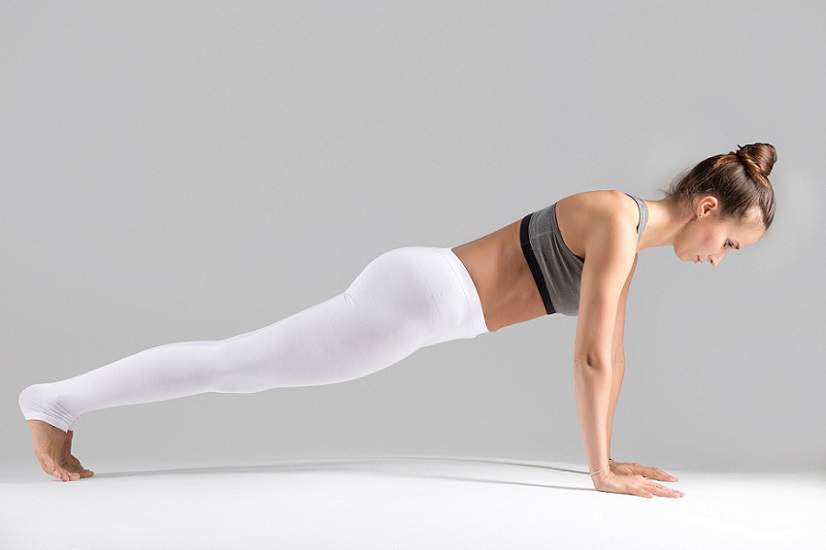Yoga Poses For Abs:
Are their really yoga poses for abs, specifically? First off, let’s talk about “core work”. There are several reasons why it’s called the core. Number one is it’s anatomical location on the body. Number 2 is that it is vital for stability. Dictionary.com states it’s the “central, innermost, or most essential part of anything”. The focus here is “essential”.
However, the core muscles (in workouts) are often overlooked, and often neglected, according to Mayclinic.com.

Many exercises that we do at the gym, a studio, or at home, work our core to some degree. However, often the core is secondary to other areas we focus on. Oftentimes, we talk about the core as focusing on the abdominals, but the core also includes back muscles, pelvis, & hips, which help create a more well-rounded, stable body.
Related Article: Improve Daily Mobility and Ease of Activities by Performing Yoga for Tight Hip Flexors
Harvard Health Publishing posted an article discussing just these details, that working the abs has it’s place, but the “smart money is on strengthening a variety of trunk muscles”.
Whether you are a high octane athlete, or an average joe, the core is vital in helping with daily functioning. A weak core for anyone, can lead to “poor posture, lower back pain and other muscle injuries”. On top of these things, it contributes to your physique, giving you a trimmer appearance.
Yoga & The Core:

In this post, we’ll dive into how yoga asanas can help to develop better core strength. Yoga and “the core” can truly work hand in hand, making this often overlooked body part, a more essential component to your everyday routines.
Yoga is an excellent way to build strength and tone up different muscle groups within your body. Contrary to what you may believe, your core muscles are no exception. Almost every activity you perform on a day-to-day basis can be improved by strengthening your core.
Yoga works so well due to it’s ability to help create a mind-body connection. This is what yoga is at it’s “core”, get it. While other exercises you perform may secondarily involve the muscles in your core, oftentimes you don’t really pay them any mind.
With the practice of yoga, and the careful attention you place on every pose, “nearly every yoga pose can be core strengthening”, according to a Shoshana Hebshi (a yoga teacher), on an article published at ACE fitness.
Above all, yoga poses require balance, stabilization, body alignment, and active thought process about each and every maneuver. Keeping your mind active and engaged in the process and importance of the core, may not only allow for better activation, but reduce risks of injury, and strengthen the muscles if done consistently.
Related Article: Yoga Maneuvers and Stretches to Help Develop Better Posture
What Does The Research Say?
One review of literature on yoga and core strength concluded that 5 different yoga asanas should be included in sports training and fitness programs when it relates to strengthening the core muscles. These include Warrior, low plank, side plank, incline plane and shoulder stand.
Other research has also concluded similar, but different findings in regards to specific yoga poses for targeting specific muscles in relation to lower back pain. The high plank, low plank and downward facing dog, in this research study was concluded to effectively target external obliques abdominis. Chair pose & Warrior 1 pose for targeting gluteus maximum. Chair pose & halfway lift for focused efforts on longissimus thoracis.
Here Are Some Yoga Poses For Abs
Boat Pose (Paripurna Navasana)
Firstly, Boat pose, a classic yoga pose for core strength, and most likely falls within the intermediate class as far as yogi difficultness. Done in the sitting position, this is a forward-bend type pose with focus on strength and balance.
The lower back, abs, pelvic region (hip flexors) and quads will also benefit and be engaged during this asana.
Steps:
1. To do the boat pose, start from a seated position on your yoga mat. Bend at your knees, allowing your feet to rest on the floor.
2. Then, exhale with hands behind your hips, begin to lean back, bringing your legs now off the floor, legs remain bent.
3. Slowly begin to straighten out or extend your legs. Make sure the core is activated, and your back remains in a straight line, trying not to arch.
4. Essentially at this time you should be sitting on your tailbone, legs straightened, now reach your arms straight out alongside your legs.
5. Breath. Hold for 10-15 seconds. Increase your time, and endurance, with practice.
Modifications to this pose is to keep your legs bent, and/or keeping your hands on the ground for stabilization.
Related Article: Yoga for Core Strength and Flexibility: Here Are Our Top 5 Poses!
Plank Pose (Phalakasana)
The plank pose (or variations of) is one of the most essential poses in yoga for core strength. This powerful yoga pose can seem easy at first, but holding for more extended periods can become quite challenging, while keeping correct form, that is. For this reason we place plank pose in a more intermediate category, as it is not difficult to get into, but holding the position is quite challenging.
The bulk of the benefits of plank pose is on strength. Furthermore, helping to establish better lower back, abdominal, and arm strength.
Steps:
1. There are several poses that you can transition from to get into proper plank. For example, Table-top, downward facing dog, or even forward fold. We’ll start from a standard table-top position, with your knee’s and hands on the ground.
2. Now, position your feet behind, getting into a push-up position. Your fingers should be spread wide, helping to balance the body.
3. Hands should be directly below your shoulders.
4. Then, instead of dipping into a full push-up maneuver, simply hold this pose. Make sure to keep your spine straight and tuck your tailbone, so your body is in as perfect straight alignment as possible.
5. Breath and hold until failure. As you build your strength, you can also transition into asanas like Dolphin Pose and Side Plank with more ease.
Forearm Plank
A variation of the plank pose is forearm plank. Similar to the previous position. The only difference is instead of having your arms extended straight forward, you’ll want to bend at the elbows and rest your forearms on your mat.
This is a slightly easier variation of the plank and is an excellent option for beginners or those who don’t have a large amount of core strength or arm strength quite yet. As you become more advanced and this pose becomes more comfortable for you, progress to full plank.
Steps:
1. Same as Plank, except come down onto the mat with your forearms! Make sure to attempt to keep that tailbone tucked down, and keep your head, torso and legs in one line.
Related Article: The Importance of Core Flexibility: Here Are Our Top Yoga Stretches to Perform for Abs!
Side Plank (Vasisthasana)
One last variation of the plank pose will engage an area that is often overlooked in the core, your obliques. Vasisthasana is an intermediate pose, because it focuses not just on strength, but balance and stretch as well.
Steps:
1. Place your right hand down on the mat, fingers pointing straight in front.
2. Then, bend your right elbow slightly, so that some of you body weight will be placed on the middle of your right hand/fingers.
3. Place your right leg down straight on the mat, and bring your left leg (bent) overtop your right thigh.
4. Press up with your left foot, so now your right thigh/lower leg is off the mat. Reach your left hand up, fingertips toward the ceiling.
5. Now lift the left leg and sit it on top of your right leg.
Proper form in this position means that you will be balanced on one side of your body with one foot and one arm forming a “triangle” below you, as your other arm reaches towards the sky. Your other leg is stacked on the first leg.
Again, this is a pose you can balance on your forearms as well if that is an easier starting point for you.
Final Thoughts
These yoga poses for core strength are great starter tools for developing a more powerful core and improving many aspects of your daily life. Many of these can be handled by beginners, then become more difficult as you progress and become more advanced within the practice.
Improved balance and stability are just a few areas that working on your core can help improve.
As always, we would love to hear your yoga stories and comments to help people along their yoga journey. Please share our posts on your social media platforms.
Resources:
- https://www.dictionary.com/browse/core
- https://www.health.harvard.edu/healthbeat/core-conditioning-its-not-just-about-abs
- https://www.mayoclinic.org/healthy-lifestyle/fitness/in-depth/core-exercises/art-20044751
- https://www.acefitness.org/education-and-resources/lifestyle/blog/6338/building-core-strength-with-yoga/
- https://www.researchgate.net/publication/322643294_A_Comprehensive_Review_of_Yoga_and_Core_Strength_Strengthening_Core_Muscles_as_Important_Method_for_Injury_Prevention_Lower_Back_Pain_and_Performance_Enhancement_in_Sports
- https://www.sciencedirect.com/science/article/abs/pii/S0965229914000107?via%3Dihub




